|
||||||
| Software Tuning Discuss all software tuning topics. |
 |
|
|
Thread Tools | Search this Thread |
|
|
#1 |
|
Senior Member
Join Date: Sep 2013
Drives: 2013 FRS
Location: SF, CA
Posts: 2,629
Thanks: 1,055
Thanked 5,469 Times in 1,494 Posts
Mentioned: 605 Post(s)
Tagged: 9 Thread(s)
|
Hi guys,
Quick tutorial on how to remap Variable Valve Timing to minimize the torque dip in the stock FA20 power curve. Below is a dyno graph of a fully modded FRS comparing stock VVT mapping our revised VVT mapping. Of course, our maps and tuning software is all free to download off of website so for many of you, this post won't be news. For everyone else, i hope you find it at least a little bit interesting. Stock vs. Revised VVT Mapping: 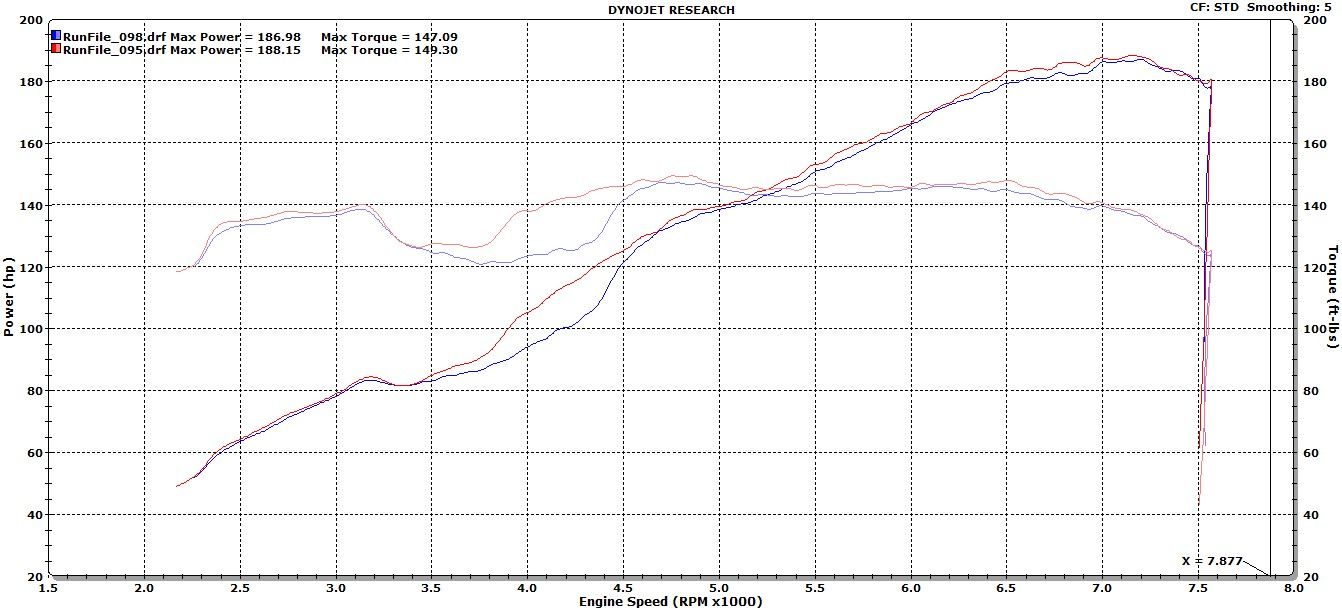 Pretty significant difference. Dip is much shorter in duration and not as deep. On the road, having nearly 20lbft of torque right where you use it the most really transforms the car. And it's easy to get. I'll disclose all the changes we make to the VVT maps. First a quick tutorial on how to read a map for those who haven't looked at this stuff before. The VVT maps are 23 (rows) x 16 (columns). The Y axis is RPM. The X axis is engine load. Engine load is defined in grams/revolution. It ranges from 0.15 to 1.4. For reference, a stock car running at sea level idles at around 0.2 (grams/rev). At full throttle it's around 0.8 at low RPM, ramping up to around 1.1 by 6000rpm and then back down to around 1.0 at 7500rpm. If you were to plot engine load by RPM you would see a shape that looks just like the torque curve. Not surprising because they both represent the engines VE (volumetric efficiency) curve. With that out of the way, here are what the stock VVT maps look like... Stock Intake VVT: 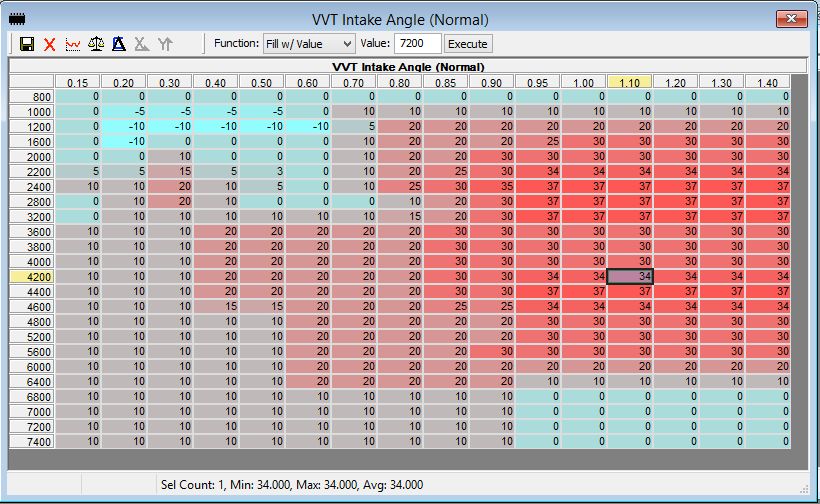 Stock Exhaust VVT: 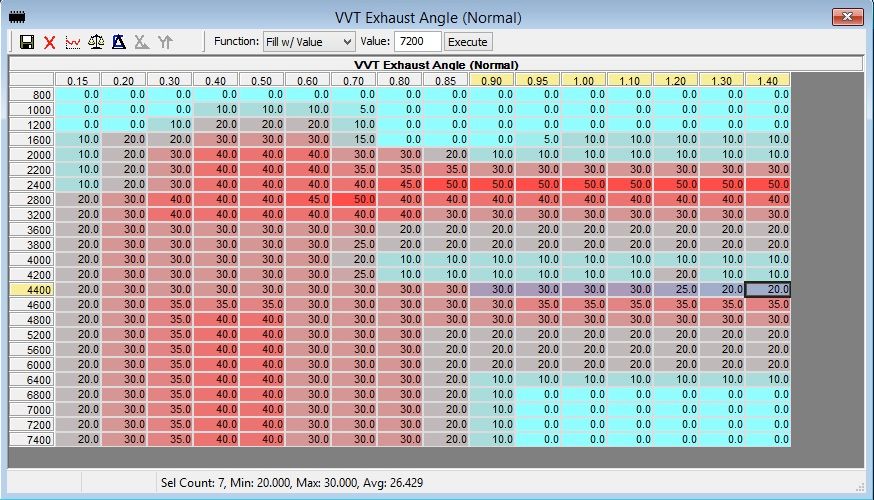 And now the modified VVT maps... Modified Intake VVT: 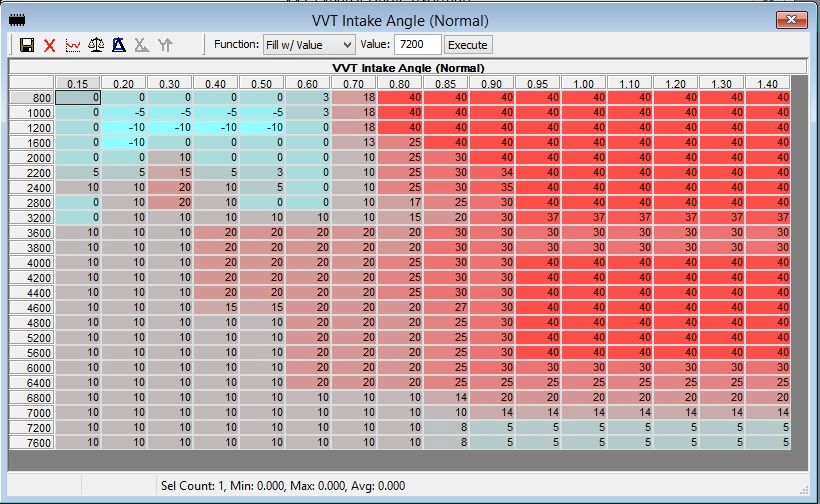 Modified Exhaust VVT: 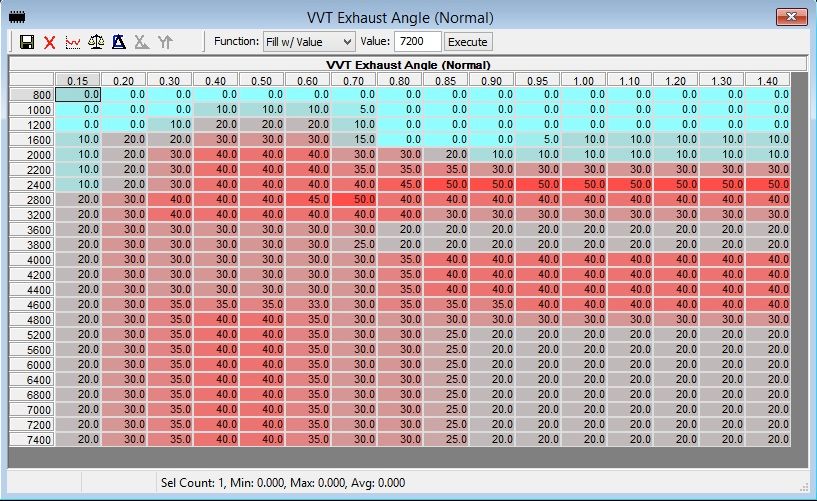 To make this easier to compare, below is a difference map showing the difference (duh) between the stock and modified maps. Difference Intake VVT: 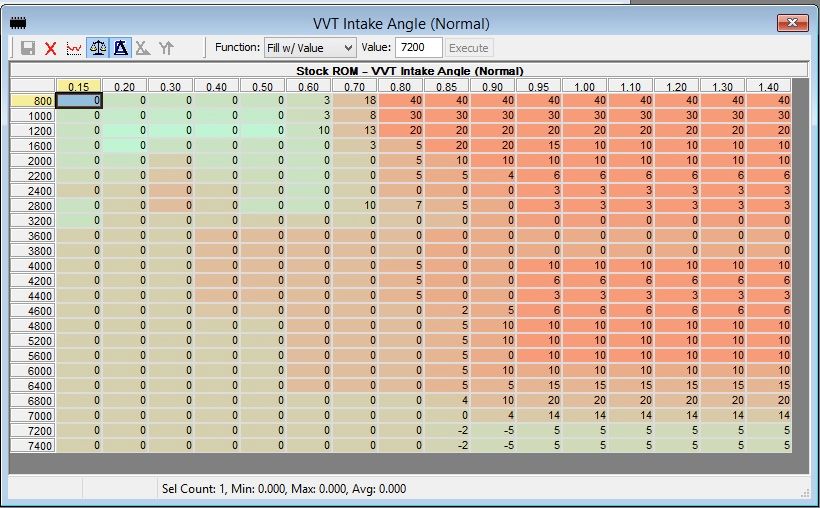 Difference Exhaust VVT:  So you can see the we selectively advanced both Intake valve timing and exhaust valve time at different load/RPM points. Mind you, we only really tuned for max load power. There is also more gains to be had at partial throttle since the factory VVT tuning is geared towards fuel efficiency and low emissions at lower engine loads. It does this by recirculating exhaust. This sucks when it comes to cylinder temps, torque and knock tendency. But it at least gives us something to fix before the next map release  In the case of the FA20 engine, advancing the intake VVT maps helped pose a bit at all engine speeds expect between 3200-3800rpm. We found that the stock mapping was ideal here. The biggest power gains were at high RPM were opening the intake valve earlier in the intake stroke improved cylinder filling (and of course power!). But the intake VVT adjustments really didn't do too much to reduce the torque dip. The exhaust VVT mapping, however, was the major contributor to filling in that torque dip. Advancing it aggressive between 4000 and 4400rpm, added huge amounts of torque. And advancing it a bit up top also helped a bit as well. That's pretty much it. There is no real magic to tuning these engines. Just a lot of trial and error on the dyno to see what it likes; I think I spent at least 6 hours just trying different combinations of intake and exhaust VVT map adjustments before I ended up with what you see above. But the results are solid and repeatable. Feel free to use them for your custom tunes. I'm sure they can be tweaked a bit depending on mods. But they should be very good starting points. Looks like whatever strange mapping decisions Toyota/Subaru made to optimize emissions/fuel economy in the torque dip area are simple to resolve. And that makes all of us very happy  Also, I'd like to thank mad_sb for his tech threads. Specifically the one about VVT mapping. It provided us with a great starting point. But not having to pay by the hour for a dyno, does gives us a lot more time to fine tune things. |
|
|

|
| The Following 49 Users Say Thank You to Shiv@Openflash For This Useful Post: | arghx7 (09-20-2013), autobrz (09-24-2013), banane63 (01-17-2014), BatStig (09-23-2013), CamryDS (10-21-2013), CARNZ (10-14-2013), clintavo (09-20-2013), Cross (09-21-2013), D-VO (04-17-2014), DAEMANO (09-20-2013), djdnz (10-21-2013), EvilBeaverFace (09-20-2013), FRSFirestorm (09-20-2013), FRSTEVE (09-20-2013), fstlane (09-20-2013), garfull (09-29-2013), Grip Ronin (09-20-2013), Guff (11-18-2013), Hanni_0176 (02-20-2014), hmong337 (09-22-2013), housecat (08-11-2015), humfrz (09-23-2013), illmatic (09-20-2013), jeebus (09-20-2013), JETRED (10-14-2013), Jetscape (10-05-2013), mad_sb (09-20-2013), microbionic (09-21-2013), Mike86 (09-23-2013), mkivsoopra (09-20-2013), mwjcyber (09-21-2013), Nightbringer (09-24-2013), nofferman (03-03-2014), Ozzman (09-21-2013), phatpanda (10-10-2013), Ralph Spoilsport (09-20-2013), RedAlert (10-18-2013), RehabJeff86 (09-20-2013), rusty959 (09-23-2013), Sing4LTS (09-20-2013), solidONE (09-24-2013), Superhatch (09-23-2013), TofuJoe (08-21-2016), Trigonx (09-20-2013), Tromatic (05-20-2014), u/Josh (09-20-2013), VR46 (09-20-2013), Wayno (07-27-2015), WillRacer1jz (09-26-2013) |
|
|
#2 |
|
Senior Member
Join Date: Jul 2012
Drives: 2015 Mustang GT (on order)
Location: San Diego
Posts: 904
Thanks: 114
Thanked 471 Times in 208 Posts
Mentioned: 9 Post(s)
Tagged: 0 Thread(s)
|
How come you start to see drastic improvements in the torque dip at 3800RPM but you don't alter anything in the exhaust VVT until 4krpm, and the intake VVT is untouched from 3200-3800 RPM? Are the changes on the intake side early on contributing to this benefit or is it because of fueling changes made in other tables?
That revised map isn't JUST revised VVT, is it?
__________________
 |
|
|

|
|
|
#3 |
|
Senior Member
Join Date: May 2012
Drives: BRZ
Location: 91351
Posts: 128
Thanks: 106
Thanked 38 Times in 23 Posts
Mentioned: 2 Post(s)
Tagged: 0 Thread(s)
|
Great stuff! Are these changes going to be put into a 1.2 tune?
|
|
|

|
|
|
#4 | |
|
Senior Member
Join Date: Sep 2013
Drives: 2013 FRS
Location: SF, CA
Posts: 2,629
Thanks: 1,055
Thanked 5,469 Times in 1,494 Posts
Mentioned: 605 Post(s)
Tagged: 9 Thread(s)
|
Quote:
Also I just realized that I posted up the dyno of our header+cat-less car running Stg 2 map[/URL]) but with the Stg 1 (v1.1) VVT maps (tuned on a phatpanda's and RehabJeff's catted cars). I'll have to edit my post and post up new screenshots of the Stg2 VVT graphs as they are slightly different in dip region which explains the discrepancy that you caught. Good eyes! Currently on a cross country flight CA->NYC so that might have to wait until tomorrow. But in-fight wifi.... winning. Also, as shown in this thread, VVT remapping was just one of the many things changed in our baseline map. This thread should actually be a continuation of that thread. Except in this thread I wanted to actually post VVT mapping values. |
|
|
|

|
|
|
#5 | |
|
Senior Member
Join Date: Sep 2013
Drives: 2013 FRS
Location: SF, CA
Posts: 2,629
Thanks: 1,055
Thanked 5,469 Times in 1,494 Posts
Mentioned: 605 Post(s)
Tagged: 9 Thread(s)
|
Quote:
|
|
|
|

|
|
|
#6 |
|
Senior Member
Join Date: Jul 2012
Drives: slow
Location: Canada
Posts: 293
Thanks: 87
Thanked 158 Times in 61 Posts
Mentioned: 1 Post(s)
Tagged: 0 Thread(s)
|
This is awesome stuff!
As a noob to this kind of stuff I have to ask: Why aren't the cars tuned like this from the factory if its so "safe"? |
|
|

|
|
|
#7 |
|
Senior Member
Join Date: Aug 2012
Drives: 2013 subaru brz
Location: United States
Posts: 136
Thanks: 102
Thanked 42 Times in 29 Posts
Mentioned: 0 Post(s)
Tagged: 0 Thread(s)
|
probably one of the biggest reasons is because you never come out with your best model highest hp version of your car in the first gen otherwise there is no room to up the ante so to speak. Its always about more power or the marketing will grow stale.
|
|
|

|
|
|
#9 |
|
Senior Member
Join Date: Nov 2011
Drives: car
Location: cold
Posts: 599
Thanks: 72
Thanked 607 Times in 185 Posts
Mentioned: 33 Post(s)
Tagged: 0 Thread(s)
|
Just to clarify, and I'm not sure how the units in the ECU were originally done here, but the exhaust cam phaser retards the closing timing and the intake cam phaser advances the intake opening timing.
I would think that what you ended up doing here was retarding the exhaust closing timing a bunch (hence the 30 degree difference at mid range). I would expect that to give a later blowdown and more scavenging. The factory tune was probably set that way to keep too much oxygen from passing through the engine and heating up the cat through exothermic reactions. Normally with a lot of intake cam advance at part load, the piston is still rising on the exhaust stroke when the intake valve opens. So you get a bunch of hot exhaust blowing out the intake port. One thing that might be interesting to try at part load is to retard the intake side (zero it out, or it looks like you can even go negative) and leave the exhaust alone. Depending on how the cam timing works out (we don't have lift vs crank angle charts so it's hard to say), that could move your overlap to when the piston is descending on the intake stroke. It depends how far the intake phaser will move though, and what the baseline intake valve opening position is. So what could happens is, you would still get some pumping work reduction but the hot exhaust gases don't blow back into the intake side and heat up the valve and port so much. Last edited by arghx7; 09-20-2013 at 07:25 PM. |
|
|

|
| The Following 4 Users Say Thank You to arghx7 For This Useful Post: |
|
|
#10 |
|
Senior Member
Join Date: Jun 2012
Drives: 2013 Scion Frs(Scarlet)
Location: Bronx, NY
Posts: 907
Thanks: 172
Thanked 386 Times in 177 Posts
Mentioned: 4 Post(s)
Tagged: 0 Thread(s)
|
this is very good info. Just wish i knew what i was looking at,and how to enhance it without screwing up. glad your teaching the forum tho. I need to really sit down and learn how to do this stuff..good stuff man keep it coming
|
|
|

|
|
|
#11 |
|
Senior Member
Join Date: Aug 2013
Drives: 2013 BRZ, WRB
Location: Galt's Gulch, NH
Posts: 225
Thanks: 107
Thanked 207 Times in 93 Posts
Mentioned: 1 Post(s)
Tagged: 0 Thread(s)
|
Did you try a smoother table with 40/40 throughout the high load part of the entire dip?
Too obvious, I realize.... |
|
|

|
|
|
#12 |
|
Senior Member
Join Date: Mar 2012
Drives: DGM BRZ, MR-S 3.5L V6 swap (sold)
Location: Bay Area, CA
Posts: 602
Thanks: 28
Thanked 188 Times in 121 Posts
Mentioned: 1 Post(s)
Tagged: 1 Thread(s)
|
For clarity, which header are you running on this car?
Thanks! |
|
|

|
|
|
#13 | |
|
Senior Member
Join Date: May 2012
Drives: '13 BRZ Ltd
Location: PA
Posts: 458
Thanks: 265
Thanked 229 Times in 117 Posts
Mentioned: 8 Post(s)
Tagged: 0 Thread(s)
|
Quote:
|
|
|
|

|
| The Following User Says Thank You to Wepeel For This Useful Post: | kombatlion (10-18-2013) |
|
|
#14 |
|
Senior Member
Join Date: Sep 2013
Drives: 2013 FRS
Location: SF, CA
Posts: 2,629
Thanks: 1,055
Thanked 5,469 Times in 1,494 Posts
Mentioned: 605 Post(s)
Tagged: 9 Thread(s)
|
Sorry guys. I'm on vacation in NYC until Tuesday night and my GF is insisting that I don't to work for at least a few days in my life. It feels weird to not look at a laptop. I'll update this post tomorrow when I get back to SF.
Quick answers: -I'm running Stivo EL headers in our test car -the first thing we tried was filling in obvious holes in the VVT graphs but, not surprisingly, that didn't give us the best results. These engines naturally don't have a linear VE profile. So their "ideal" VVT maps won't be pretty looking. I tested all sorts of intake and exhaust VVT combinations and what is in our OTS maps are the best I found. At full throttle, at least. Still have some more partial throttle VVT optimization to do I think. |
|
|

|
| The Following User Says Thank You to Shiv@Openflash For This Useful Post: | Ralph Spoilsport (09-23-2013) |
|
|
|
|
 |
| Tags |
| open stealing tablet, throttle response |
|
|
 Similar Threads
Similar Threads
|
||||
| Thread | Thread Starter | Forum | Replies | Last Post |
| Official OpenFlash Tablet FA20 Tuning Tech Discussion Thread | Rombinhood@OpenFlash | Software Tuning | 2594 | 08-01-2017 01:03 AM |
| OpenFlash Tuning Tech: Tales from the Dyno (Stock, Ecutek and OpenFlash tunes) | Rombinhood@OpenFlash | Software Tuning | 237 | 02-10-2014 03:35 PM |
| Tein H-Tech & S-Tech / Street Basis Coilovers & More / Great Deals @ Import DPS!! | rickspecd | Brakes, Suspension, Chassis | 4 | 07-12-2013 11:49 AM |